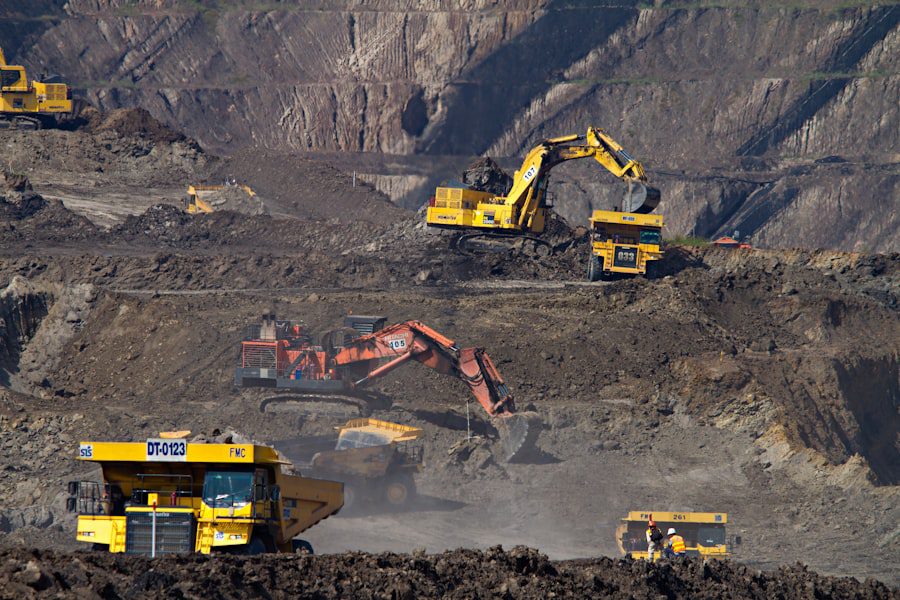The coal supply chain plays a crucial role in the global energy industry, as coal remains a significant source of power generation in many countries. Optimizing the coal supply chain is essential for ensuring a reliable and efficient flow of coal from the extraction site to the end-user. A well-optimized coal supply chain can lead to cost savings, improved operational efficiency, and reduced environmental impact. By streamlining the processes involved in coal mining, transportation, and storage, stakeholders can minimize waste, mitigate risks, and enhance overall productivity.
Efficient coal supply chain management is also vital for meeting the growing demand for energy worldwide. As the global population continues to increase, so does the need for electricity and heat, which are often derived from coal-fired power plants. By optimizing the coal supply chain, stakeholders can ensure a steady and uninterrupted flow of coal to power plants, thereby contributing to energy security and stability. Additionally, a well-managed coal supply chain can help minimize disruptions caused by external factors such as natural disasters, geopolitical tensions, or market fluctuations. Overall, optimizing the coal supply chain is essential for meeting energy demands, reducing costs, and enhancing sustainability in the energy sector.
Key Takeaways
- Optimizing the coal supply chain is crucial for ensuring a steady and reliable flow of coal to meet energy demands.
- Key challenges in the coal supply chain include transportation bottlenecks, inventory management, and environmental regulations.
- Strategies for improving efficiency in the coal supply chain include implementing advanced technologies, streamlining logistics, and optimizing inventory management.
- Implementing sustainable practices in the coal supply chain is essential for reducing environmental impact and meeting regulatory requirements.
- Technology and innovation play a key role in improving the coal supply chain, with advancements in automation, data analytics, and digitalization driving efficiency and cost savings.
Key Challenges in the Coal Supply Chain
Despite its importance, the coal supply chain faces several challenges that can hinder its efficiency and effectiveness. One of the primary challenges is the complex and geographically dispersed nature of coal mining operations. Coal mines are often located in remote areas, making transportation and logistics a significant challenge. Additionally, the extraction and processing of coal involve various stages, each with its own set of logistical and operational complexities. As a result, coordinating and managing the flow of coal from mines to end-users can be a daunting task.
Another key challenge in the coal supply chain is the environmental impact associated with coal mining and transportation. The extraction and combustion of coal can result in air and water pollution, habitat destruction, and greenhouse gas emissions. As a result, there is increasing pressure on stakeholders in the coal supply chain to adopt sustainable practices and reduce their environmental footprint. Furthermore, regulatory requirements and public scrutiny add another layer of complexity to the coal supply chain, as stakeholders must navigate stringent environmental standards and public perception.
In addition to these challenges, the coal supply chain is also vulnerable to market volatility and geopolitical risks. Fluctuating coal prices, trade disputes, and political instability in key coal-producing regions can disrupt the flow of coal and impact supply chain operations. Moreover, the transition towards renewable energy sources poses a long-term challenge for the coal supply chain, as it may lead to reduced demand for coal in the future. Addressing these challenges requires innovative strategies and collaborative efforts across the coal supply chain.
Strategies for Improving Efficiency in the Coal Supply Chain
To overcome the challenges facing the coal supply chain and improve its efficiency, stakeholders can implement various strategies at different stages of the supply chain. At the mining stage, adopting advanced technologies such as autonomous vehicles, drones, and real-time monitoring systems can enhance productivity and safety. These technologies can help optimize mining operations, reduce downtime, and improve resource utilization. Additionally, implementing predictive maintenance practices can help prevent equipment failures and minimize disruptions in coal extraction.
In terms of transportation and logistics, stakeholders can leverage digital solutions such as transportation management systems (TMS) and route optimization software to streamline the movement of coal from mines to end-users. These tools can help minimize transportation costs, reduce fuel consumption, and optimize delivery schedules. Furthermore, investing in infrastructure improvements such as rail upgrades, port facilities, and storage terminals can enhance the efficiency of coal transportation and storage.
Another key strategy for improving efficiency in the coal supply chain is to focus on inventory management and demand forecasting. By implementing advanced inventory tracking systems and demand planning tools, stakeholders can better anticipate market demand and optimize their inventory levels. This can help reduce stockpiling costs, minimize waste, and ensure a steady supply of coal to meet customer needs. Moreover, adopting lean principles and continuous improvement practices can help identify and eliminate inefficiencies across the entire coal supply chain.
Implementing Sustainable Practices in the Coal Supply Chain
| Metrics | Data |
|---|---|
| Reduction in CO2 emissions | 20% decrease from baseline |
| Renewable energy usage | 30% of energy sourced from renewable sources |
| Water conservation | 10% reduction in water usage |
| Waste management | Recycling rate of 80% |
In response to growing environmental concerns, stakeholders in the coal supply chain are increasingly focusing on implementing sustainable practices to minimize their impact on the environment. One key area of focus is reducing greenhouse gas emissions associated with coal mining and combustion. This can be achieved through the adoption of cleaner technologies such as carbon capture and storage (CCS) and emissions control systems. By capturing and storing carbon dioxide emissions from coal-fired power plants, stakeholders can mitigate their environmental impact and contribute to climate change mitigation efforts.
Another important aspect of sustainable practices in the coal supply chain is minimizing water usage and pollution. Coal mining operations often require significant amounts of water for extraction and processing, which can lead to water scarcity and contamination if not managed properly. Implementing water recycling systems, treatment facilities, and responsible mining practices can help reduce water consumption and protect local water sources from pollution.
Furthermore, reclamation and rehabilitation of mined areas are essential for restoring ecosystems and minimizing habitat destruction caused by coal mining activities. Stakeholders can implement reforestation programs, wildlife habitat restoration initiatives, and land reclamation projects to mitigate the environmental impact of mining operations. Additionally, engaging with local communities and indigenous groups to ensure their participation in sustainable land use practices is crucial for fostering social responsibility and environmental stewardship in the coal supply chain.
Technology and Innovation in the Coal Supply Chain
Advancements in technology and innovation are driving significant changes in the coal supply chain, offering new opportunities for improving efficiency and sustainability. One key area of innovation is the use of digitalization and data analytics to optimize supply chain operations. By leveraging big data analytics, machine learning algorithms, and Internet of Things (IoT) devices, stakeholders can gain valuable insights into their supply chain processes and make data-driven decisions to enhance efficiency.
Furthermore, automation and robotics are revolutionizing coal mining operations by improving safety, productivity, and cost-effectiveness. Autonomous mining equipment, robotic process automation (RPA), and remote monitoring systems are enabling stakeholders to streamline mining activities while reducing human intervention in hazardous environments. This not only enhances worker safety but also increases operational efficiency by minimizing downtime and optimizing resource utilization.
In addition to these advancements, blockchain technology is being explored as a means to enhance transparency and traceability in the coal supply chain. By utilizing blockchain-based platforms for tracking transactions, certifications, and compliance records, stakeholders can improve trust and accountability across the supply chain. This can help address concerns related to ethical sourcing, regulatory compliance, and sustainability certifications in the coal industry.
Collaboration and Communication in the Coal Supply Chain

Effective collaboration and communication among stakeholders are essential for optimizing the coal supply chain and addressing its challenges. Building strong partnerships between coal producers, transportation companies, power plants, regulatory authorities, and local communities is crucial for aligning interests and coordinating efforts across the supply chain. By fostering open communication channels and sharing information transparently, stakeholders can better anticipate market dynamics, regulatory changes, and operational requirements.
Furthermore, collaboration can lead to shared resources and infrastructure investments that benefit multiple stakeholders in the coal supply chain. For example, developing shared rail networks, port facilities, or storage terminals can reduce costs and improve efficiency for all parties involved. Additionally, joint research and development initiatives focused on sustainable technologies, operational best practices, or safety improvements can drive innovation across the entire supply chain.
Effective communication is also vital for engaging with local communities impacted by coal mining activities. By proactively addressing community concerns, respecting indigenous rights, and promoting social responsibility initiatives, stakeholders can build trust and foster positive relationships with local residents. This can help mitigate social conflicts, regulatory hurdles, and reputational risks associated with coal mining operations.
The Future of the Coal Supply Chain: Trends and Opportunities
Looking ahead, several trends and opportunities are shaping the future of the coal supply chain. One key trend is the increasing adoption of renewable energy sources as a substitute for coal-fired power generation. This transition presents opportunities for stakeholders to diversify their energy portfolios and invest in cleaner technologies such as solar, wind, or hydroelectric power. Additionally, integrating renewable energy sources with advanced energy storage solutions can help balance grid reliability while reducing reliance on coal.
Another trend is the growing emphasis on circular economy principles within the coal supply chain. By promoting resource efficiency, waste reduction, and recycling initiatives, stakeholders can minimize environmental impact while maximizing value from by-products generated during coal extraction and processing. For example, converting coal combustion by-products into construction materials or industrial chemicals can create new revenue streams while reducing waste disposal costs.
Furthermore, there are opportunities for leveraging digital platforms and marketplaces to optimize trading and procurement processes within the coal supply chain. By embracing e-commerce platforms, digital trading exchanges, or blockchain-based marketplaces, stakeholders can streamline procurement activities while enhancing transparency and efficiency in coal transactions.
In conclusion, optimizing the coal supply chain is essential for meeting energy demands while minimizing environmental impact and maximizing operational efficiency. By addressing key challenges through innovative strategies such as technology adoption, sustainable practices implementation, collaboration enhancement, stakeholders can position themselves for success in an evolving energy landscape. Embracing trends such as renewable energy integration, circular economy principles adoption will enable stakeholders to capitalize on new opportunities while navigating future uncertainties in the coal supply chain.
If you are interested in learning more about the dependable coal briquette supply chain for industry, you should check out this article on Almassiyah. It provides valuable insights into how the coal supply chain can be optimized to ensure a reliable and sustainable source of fuel for various industries.
FAQs
What is coal supply chain optimization?
Coal supply chain optimization refers to the process of improving the efficiency and effectiveness of the various stages involved in the supply chain of coal, from mining to transportation to delivery to the end user. This involves minimizing costs, reducing waste, and maximizing the overall value of the coal supply chain.
Why is coal supply chain optimization important?
Coal supply chain optimization is important because it can lead to cost savings, improved productivity, and reduced environmental impact. By optimizing the various stages of the coal supply chain, companies can improve their competitiveness and sustainability.
What are the key components of coal supply chain optimization?
The key components of coal supply chain optimization include mine planning and scheduling, transportation logistics, inventory management, and demand forecasting. Each of these components plays a crucial role in ensuring the smooth and efficient flow of coal from the mine to the end user.
How can technology be used to optimize the coal supply chain?
Technology can be used to optimize the coal supply chain in various ways, such as through the use of advanced data analytics for demand forecasting, real-time tracking and monitoring of coal shipments, and the implementation of automated systems for inventory management and scheduling.
What are the benefits of coal supply chain optimization?
The benefits of coal supply chain optimization include reduced costs, improved operational efficiency, better resource utilization, and a reduced environmental footprint. Additionally, optimized coal supply chains can lead to improved customer satisfaction and overall business performance.



